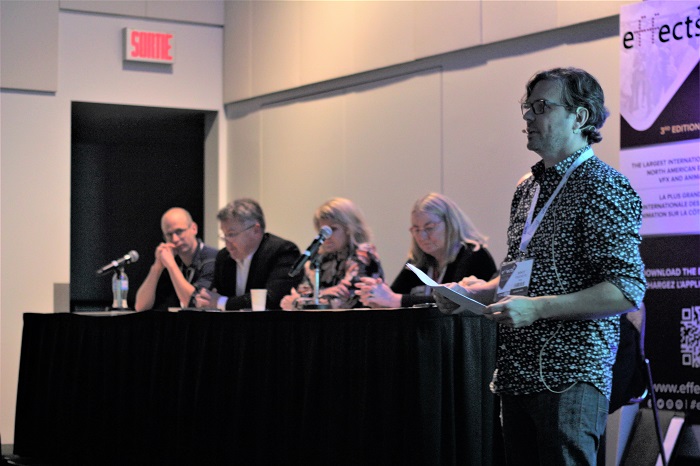Montreal hosted the east coast’s largest international VFX and animation conference
The high-quality visual effects seen in newly released films such as Ghosts in the Shell and Deadpool are a testament to how the visual effects (VFX) and animation industries are thriving. In both of these movies, the outstanding imagery was created by the Montreal-based VFX studio, Atomic Fiction.
“Every year the creative challenges are different,” said Kevin Baillie, the co-founder and VFX supervisor at Atomic Fiction. “Nineteen of the 20 highest-grossing films of 2016 were VFX and animation driven. This shows how people care about the work that we do—they love it.”
Baillie had high praise for the VFX industry as he addressed the crowd at this year’s Effects MTL, the largest international VFX and animation conference on the North American east coast. On Sept. 6 and 7, film producers, graphic designers, artists, students and fans of VFX films gathered at Palais des congrès for the conference.
During the opening keynote talk, Baillie discussed the challenges he has faced as an artist and a studio owner. “We put ourselves on the line everyday. We do so creatively, technically and financially,” he said. “When I put something on the line, I feel like the world is looking at me, waiting for me to screw up.” In retrospect, Baillie said, he should not be so worried about making mistakes. “It’s important to embrace the fact that people aren’t watching you that closely and to take some risks, move forward and be open,” he said.
Being among leaders of the VFX film industry and hearing about their journeys as producers was a rich learning experience for attendees looking to make a career in VFX or film production. The event included a multitude of panel conferences featuring major producers from companies such as Industrial Light & Magic (ILM), one of the most well-known VFX companies in the world. The discussed topics ranged from the lack of women in the VFX field to the visual effects seen on Game of Thrones.
Effects MTL also offered master classes (similar to workshops), where artists and animators got one-on-one time with experts on specific topics such as animal and human anatomy in VFX. There was also a job fair, which was a great opportunity for networking. It was a hub for aspiring graphic designers and visual artists searching for a career with leading companies in the industry.
During his talk, Baillie suggested the best way to advance the VFX industry is to recognize the full potential and talent of the visual effects and animation industries. He listed a few things he believes can help companies within the VFX industry in the future. Baillie said he has noticed that VFX companies often try to have too many specialities.“There are lots of different categories, such as episodic, film, special venues—it’s important that we, as visual effects companies, recognize the limits of what each of these areas of focus demands and make sure not to be over-committed,” he said.
Baillie’s company, Atomic Fiction, is currently working on the Netflix-original drama TV series Stranger Things as well as some movies. “It’s really hard getting into the groove and context switching from one work to another even if they are similar,” he said.
Baillie also mentioned how hiring the right people and having diversity and culture in the work environment are important tools for success. “Nobody wants to work with a whole bunch of people who are exactly like themselves. I think that is the killer of creativity,” he said. “We want to make sure that we have an as diversified workforce as possible.”
Effects MTL had a total of 1,100 attendees this year, and welcomed 266 companies along with 60 exhibitors and sponsors. The conference’s main sponsors were Atomic Fiction and the Montreal-based video production company, MELS.
Another Effects MTL panel, presented by the Québec Film and Television Council, assembled VFX film producers to share their work experiences. Among them were Gretchen Libby from ILM; Nancy St. John, who is an independent VFX director; film producer William W. Wilson III; Randy Starr from Legendary Pictures and Eli Dolleman from Amazon Studios. The panel moderator was Benoît Touchette, the head of visuals at MELS Studios.
The audience was composed of people working for visual effect companies, graphic designers, visual artists and students. An important yet simple question was raised: how does one become a VFX film producer? The panelists agreed that a strong work ethic and great communication skills are important qualities to have for this job. According to Libby, it’s also important for aspiring film producers to understand the many roles and steps that go into producing a live-action shot.
“We really are the meeting place of the film world—everything that the film world does eventually comes to us,” she said. “If you can involve yourself in student projects that touch on various other elements of the filmmaking process, I think it’s really important to bring that knowledge to what we do in visual effects.”
Dolleman, who worked as a freelance producer, said producing for television or movies is a unique career. “As a person who could never figure out what to do, if you have a lot of different interests, producing is almost the perfect track to take—one day you are worried about the balance sheet, another day you are trying to solve a creative problem, another day you are dealing with political issues,” he said. “It truly gives an opportunity to deal with a lot of different things.”
